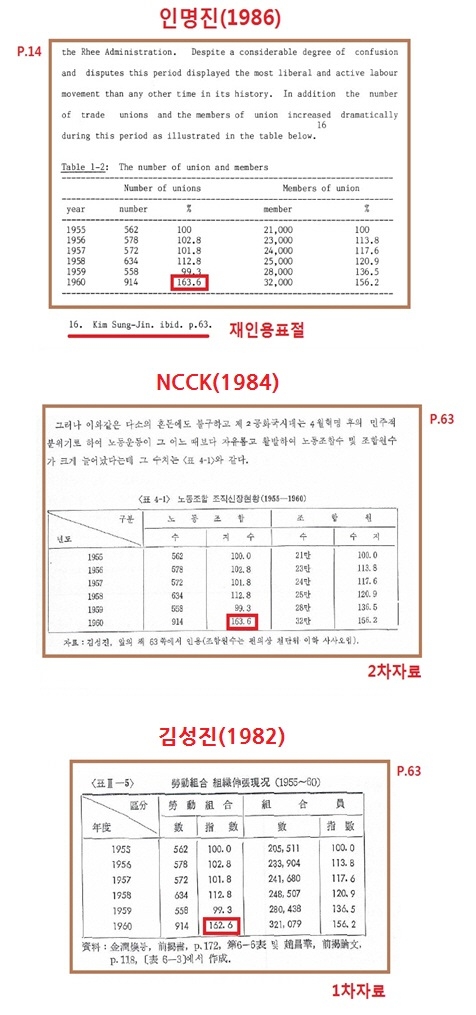
Despite a considerable degree of confusion and disputes this period displayed the most liberal and active labour movement than any other time in its history. In addition the number of trade unions and the menbers of union increased dramatically during this period as illustrated in the table below(상당한 정도의 혼란과 분쟁이 있었음에도/ 이기간은 보여주었다/ 자장 자유롭고 활동적인 노동운동을/ 다른 어느 때 보다도/ 노동운동 역사에 있어서/. 또한 노동조합과 노조원의 수는 극적으로 증가했다./ 이 기간동안/ 아래의 표에 설명되어 있듯이/)
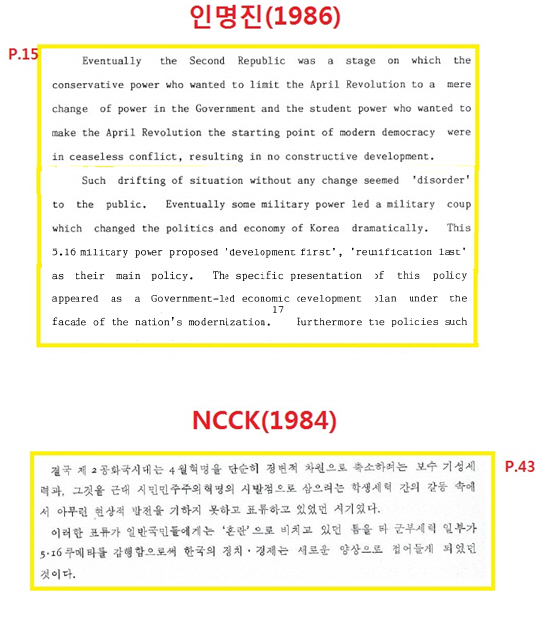
Eventually the Second Republic was a stage on which the conservative power who wanted to limit the April Revolution to a mere change of power in the Government and the student power who wanted to make the April Revolution the starting point of modern democracy were in ceaseless conflict, resulting in no constructive development.(결국 제2공화국은 단계였다/ 보수세력과/ 4월 혁명을 정권의 단순한 변화로 한정짓기를 원하는/ 학생세력은/ 4월 혁명을 현대 민주주의의 출발점으로 삼기를 원했던/ 끊임없이 충돌하는 단계/ 어떠한 건설적 발전도 결과적으로 없었던/)Such drifting of situation without any change seemed 'disorder'to the public. Eventually some military power led a military coup which changed the politics and economy of Korea dramatically.(어떠한 변화도 없는 이러한 상황의 변화는 사람들에게 보였다/ ‘무질서’로/ 결국 군부세력은 쿠데타를 이끌었다/ 한국의 정치, 경제를 획기적으로 변화시킬/.)
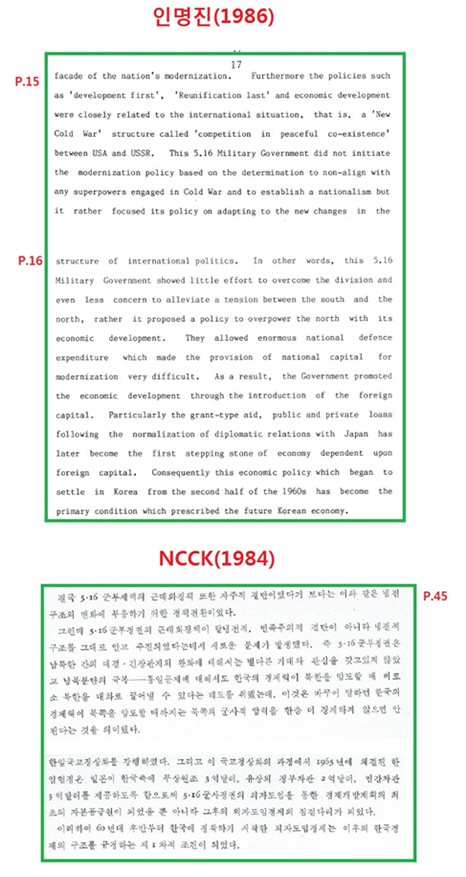
Furthermore the policies such as 'development first', 'Reunification last' and economic development were closely related to the international situation, that is, a 'New Cold War' structure called 'competition in peaceful co-existence' between USA and USSR. This 5. 16 Military Government did not initiate the modernzation policy based on the determination to non-align with any superpowers engaged in Cold War and to establish a nationalism but it rather focused its policy on adapting to the new changes in the(게다가 ‘선성장, 후통일’과 경제개발과 같은 정책은 밀접히 관련이 있었다/ 국제 정세와/ 즉 ‘신냉전’ 구조/ 미국과 소련 간의 ‘평화공존 경쟁’ 이라 불리는/. 이 5.16 군사 정부는 현대화정책을 주도하지 않았다/ 냉전시대에 있어서 어떠한 강대국으로부터도 동맹을 맺지 않고 해나가겠다는 것과/ 민족주의를 수립하기 위한 결정에 기반한/ 군사정부는 오히려 새로운 변화에 적응하는 정책에 초점을 맞추었다./)structure of international politics. In other words, this 5. 16 Military Government showed little effort to overcome the division and even less concern to alleviate a tenion between the south and the north, rather it proposed a policy to overpower the north with its economic development. They allowed enormous national defence expenditure which made the provision of national capital for modernization very difficult. As a result, the Government promoted the economic development through the introduction of the foreign capital. Particularly the grant-type aid, public and private loans fellowing the normalization of diplomatic relations with Japan has later become the first stepping stone of economic pojlicy which began to settle in Korea from the second half of the 1960s has become the primary condition which prescribed the future Korean economy.(국제정치의 구조 / 다시 말하면 이 5. 16 군사정부는 거의 노력을 보여주지 않았다/ 분단을 극복하려는/ 심지어 남북간의 긴장을 감소시키려는 어떠한 관심도 보여주지 않았다/ 오히려 경제적 발전을 통해서 북쪽보다 힘을 키우려는 정책을 제시했다./ 군사정부는 막대한 군사비용을 허용했다/ 근대화를 위한 국가 자본을 확보하기 어렵게 만들었다./ 그 결과 정부는 촉진했다/ 경제개발을/ 외국자본의 도입을 통한/ 특히 보조금 형태의 원조와 공적, 사적 대출은 / 일본과의 관계 정상화 이후의/ 후에 경제정책의 시금석이 되었는데./ 1960대 후반기부터 한국에 정착하기 시작한/ 이러한 외자도입은 기본 조건이 되었다/ 그 이후의 한국경제를 규정하는/)
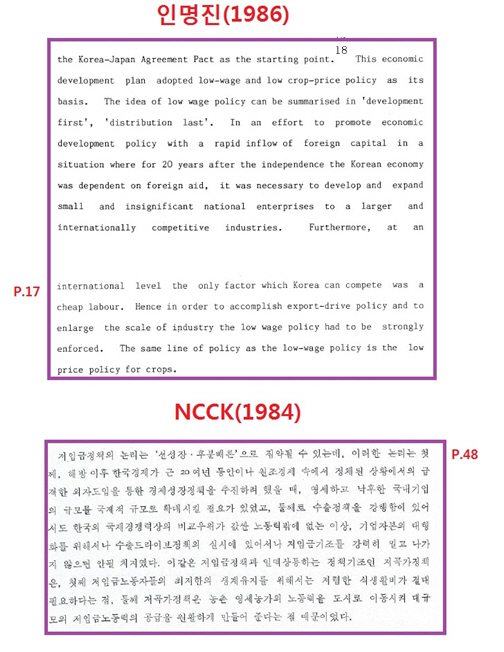
This economic development plan adopted low-wage and low crop-price policy as its basis. The idea of low wage policy can be summarised in 'development first', 'distribution last', In an effort to promote economic development policy with a rapid inflow of foreign capital in a situation where for 20 years after the independence the Korean economy was dependent on foreign aid, it was necessary to develop and expand small and insigificant national enterprises to a larger and internationally competitive industries. Furthermore, at an international level the only factor which Korea can compete was a cheap labour. Hence in order to accomplish export-drive policy and to enlarge the scale of industry the low wage policy had to be strongly enforced. The same line of policy as the low-wage policy is the low price policy for crops.(이 경제개발 계획은 채택하였다/ 저임금 및 저가 농산품 정책을/ 기본적으로/. 저임금 정책의 개념은 요약될 수 있다/ ‘선성장, 후분배’로/. 경제개발 정책을 추진하는 노력에 있어서/ 빠른 외자도입을 가지고/ 독립 후 20년 동안 한국경제는 외국원조에 의존한 상황 하에서/ 경제정책에 있어서 필수적이었던 것은/ 작고 중요치 않은 국영기업을 더 크게 하고 국제 경쟁력있는 기업으로 발전시키고 확장하는 것이었다./ 더욱이 국제적 차원에서 유일한 요소라 한다면/ 한국이 경쟁력 있는/ 값싼 노동력이었다./ 게다가 수출주도정책을 환수하고 산업의 규모를 크게하기 위해 저임금 정책이 강력이 집행되어야 했다./ 저임금 정책과 동일한 정책선상에 있는 것이 저가 농산물 정책이다/.)
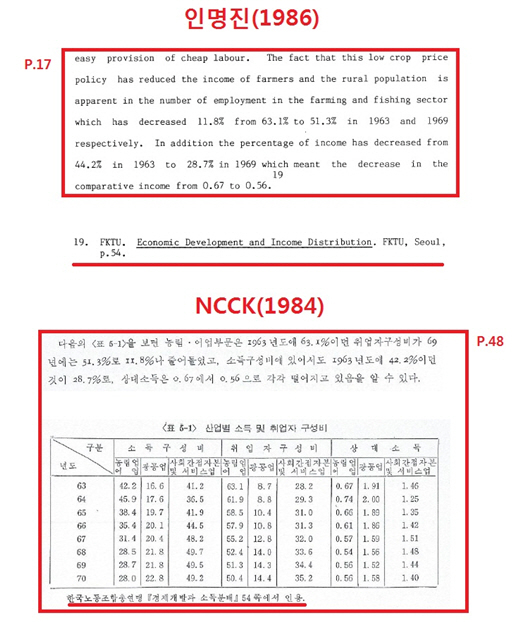
The fact that this low crop price policy has reduced the income of farmers and the rural population is apparent in the number of employment in the farming and fishing sector which has decreased 11. 8% from 63.1% to 51.3% in 1963 and 1969 respectively. In addition the percentage of income has decreased from 44.2% in 1963 to 28.7% in 1969 which meant the decrease in the comparative income from 0.67 to 0.56.(사실/ 이 저가 농산물 정책이 농민들의 소득과 농촌인구를 감소시켰다는 / 분명히 나타난다/ 농어촌 부문에 있어서 고용률 감소로/ 1963년과 1969년에 각각 63.1%에서 51.3%로 11.8%감소/ 또한 소득의 비율은 감소했다/ 1963년에 44.2%에서 1969년에 28.7%로/ (타부문과의)비교소득이 0.67%에서 0.56%로 감소함을 의미하는/)
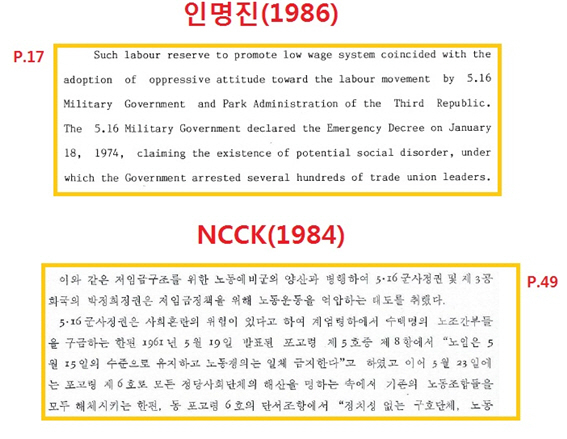
Such labour reserve to promote low wage system coincided with the adoption of oppressive attitude toward the labour movement by 5.16 Military Government and Park Administration of the Third Republic. The 5.16 Military Government declared the Energency Decree on January 18, 1974, claiming the existence of potential social disorder, under which the Government arrested several hundreds trade union leaders.(그러한 산업 예비군은/ 저임금 체계를 촉진하기 위한/ 억압적인 태도의 채택과 일치한다/ 노동운동에 대한/ 5.16 군사정부와 제3공화국의 박정희 정부에 의한/. 5.16 군사정부는 선언했다/ 긴급조치 법령을/ 1월 18일 1974년/ 잠재적 사회 무질서의 현존을 주장하면서/ 정부는 수백 명의 노조 간부들을 체포하면서)
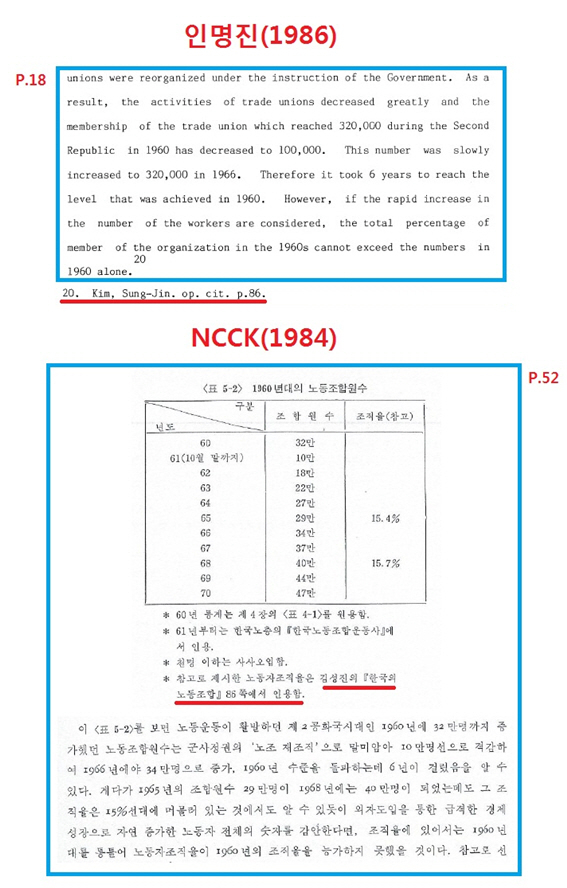
unions were reorganized under the instruction of the Government. As a result, the activities of trade unions decreased greatly and the menbership of the trade union which reached 320,000 during the Second Republic in 1960 has decreased to 100,000. This number was slowly increased to 320,000 in 1966. Therefore it took 6 years to reach the level that was achieved in 1960. However, if the rapid increase in the number of the workers are considered, the total percentage of member of the organization in the 1960s cannot exceed the numbers in 1960 alone.(노동조합은 재편되었다/ 정부의 지도에 의해/ 그 결과 노조의 활동이 크게 줄어들었고/ 노조원는/ 1960년 제2공화국 시기에 320,000에 달했던/ 줄어들었다/ 100,000으로/. 1966년에 320,000까지 서서히 증가했던 노조원 수는/. 그러므로 6년이 걸린 셈이다/1960년에 도달했던 수준에 이르는데/ 그러나 노동자의 수가 빠르게 증가한 것을 고려한다면 1960년대 노조수의 전체 퍼센트지는 1960년 한해의 노조수보다 넘지 않는 것이다./)
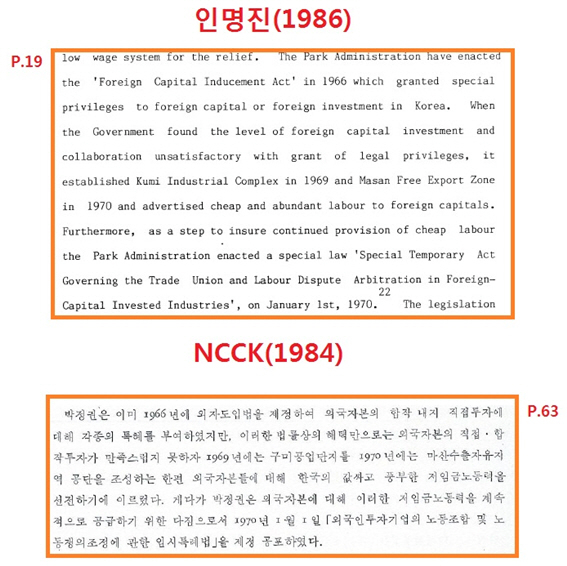
The Park Administration have enacted the 'Foreign Capital Inducement Act' in 1966 which granted special privileges to foraign capital or foreign investment in Korea. When the Government found the level of foreign capital investment and collaboration unsatisfactory with grant of legal privileges, it established Kumi Industrial Complex in 1969 and Masan Free Export Zone in 1979 and advertised cheap and abundant labour to foreign capitals. Furthermore, as a step to insure continued provision of cheap labour the Park Administration enacted a special law 'Special Temporary Act Governing the Trade Union and Labour Dispute Arbitration in Foreign-Capital Invested Industries', on January 1st, 1970.(박정희 정부는 시행했다/. ‘외국인 투자 촉진법’을/ 1966년에/ 한국에 대한 외국 자본 혹은 외국투자에 대해 특권을 부여하는/. 정부가 외국자본의 투자와 합작 수준이 만족스럽지 않은 것을 알았을 때, 정부는 설립했다/ 1969년 구미산업공단과 1979년 마산자유무역지대를/ 그리고 싸고 풍부한 노동력을 외국자본들에게 알려주었다./ 더욱이 저렴한 노동력의 지속적인 공급을 확보하기 위한 조치로/ 박정희 정부는 시행했다/ 특별법 ‘외국인 투자기업의 노동조합과 노동분쟁 규정에 관한 임시 특례법’을 / 1970년 1월 1일에/.)
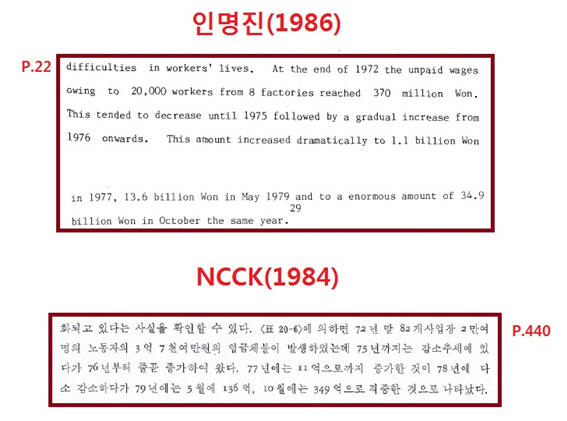
At the end of 1972 the unpaid wages owing to 20,000 workers from 8 factories reached 370 million Won. This tended to decrease until 1975 followed by a gradual increase from 1976 onwards. This amount increased dramatically to 1.1 billion Won in 1977, 13.6 billion Won in May 1979 and to a enormous amount of 34.9 billion Won in October the same year.(1972년 말 8개 공장 2만 명의 근로자들의 미지급 임금은 3억 7000만원에 이른다./ 이것은 1975년까지 줄고/ 점차적으로 증가하였다. 1976년 이후로/ 이 금액은 극적으로 증가하였다/ 1977년에 11억원, 1979년 5월엔 136억 원, 그리고 같은해 10월 349억 원으로 엄청난 양으로/)
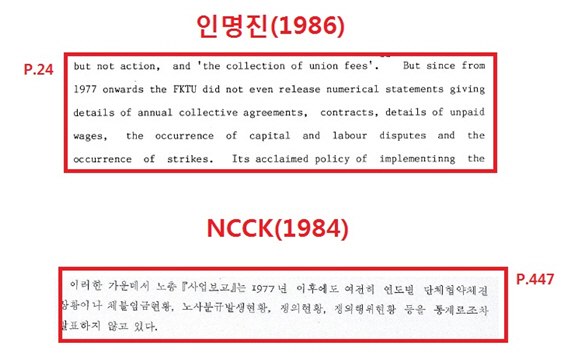
But since from 1977 onwards the FKTU did not even release numerical statements giving details of annual collective agreements, contracts, details of unpaid wages, the occurrence of capital and labour disputes and the occurrence of strikes.(그러나 1977년 이후로 한국노총은 발표하지 않았다. 세부적인 수치들을/ 연례 단체협약, 계약, 미지급 세부 사항들, 자본 및 노동 분쟁 발생, 파업의 발생 등에 대한./)
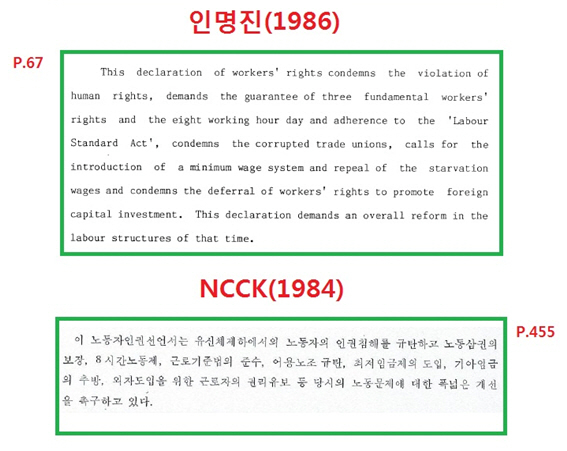
This declaration of workers' rights condemns the violation of human rights, demands the guarantee of three fundamental workers' rights and the eight working hour day and adherence to the 'Labour Standard Act', condemns the corrupted trade unions, calls for the introduction of a minimum wage system and repeal of the starvation wages and condemns the deferral of workers' rights to promote foreign capital investment. This declaration demands an overall reform in the labour structures of that time.(이 노동자 권리선언은 규탄한다/ 인권침해를/ 요구한다/ 노동 3권과 하루 8시간 노동제와 노동기준법의 준수를/ 비난한다/ 부패한 노동조합을/ 요구한다/ 최저인금제의 도입과 기아임금의 폐지를/ 비난한다/ 외국자본 투자 촉진을 위한 노동자의 권리를 유보함을/. 이 선언은 요구하다/ 전반적인 개혁을/ 그 당시 노동구조에 대한/.)
ⓒ 미디어워치 & mediawatch.kr